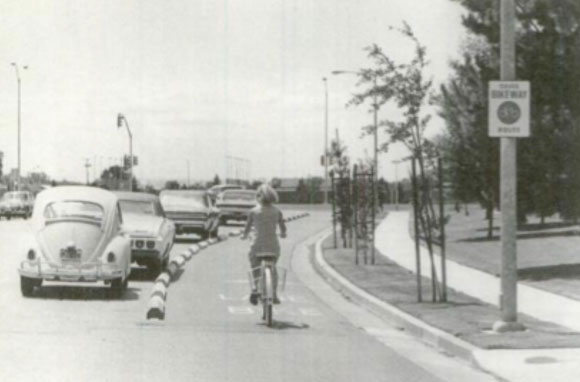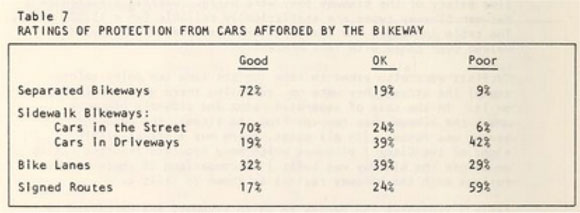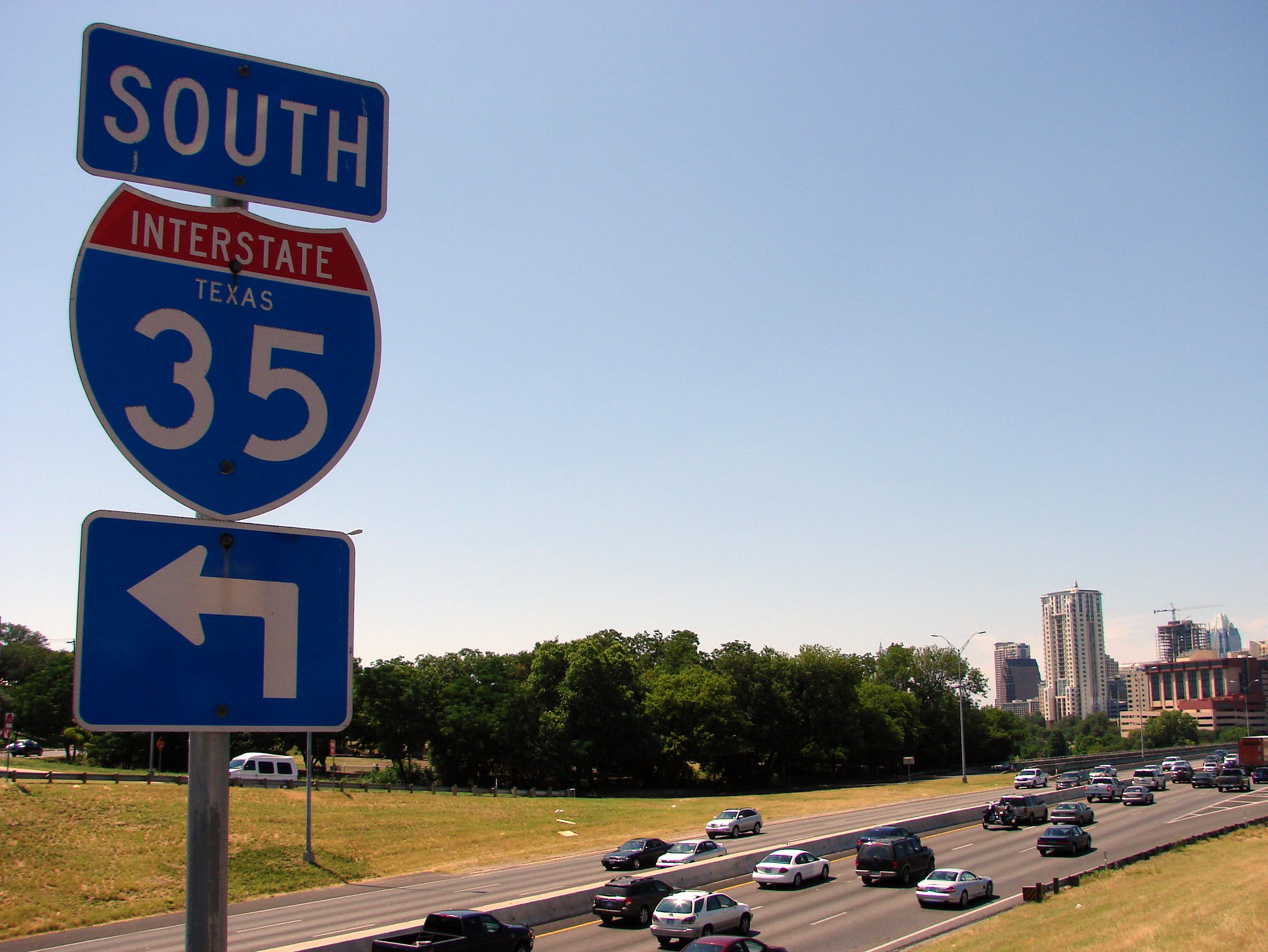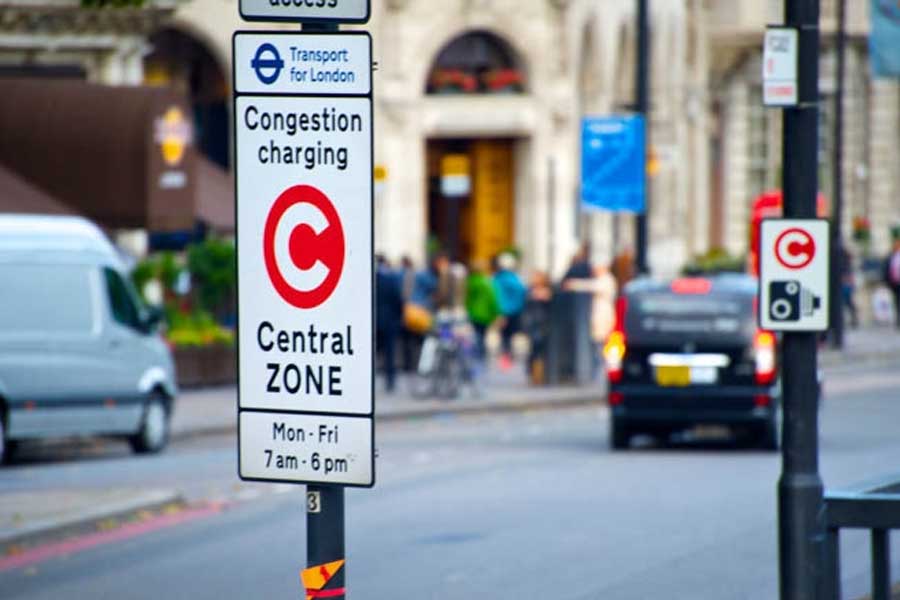
Salt Lake City is on track to implement the nation’s first "protected intersection" -- a Dutch-inspired design to minimize conflicts between cyclists and drivers at crossings. For American cities, this treatment feels like the cutting edge, but a look back at the history of bike planning in the United States reveals that even here, this idea is far from new. In fact, the protected intersection concept appeared in every foundational document for bike planning in the early 1970s. But no American city ever installed one until now -- here's why.
First, some background. The first modern on-street bike lanes in the United States were installed in Davis, California, in the fall of 1967. Of these three bike lanes, one was a parking-protected bikeway on Sycamore Drive. That’s right: The first on-street bike lane in the United States was a parking-protected bikeway.
As word of the Davis bike lanes spread across the country, cities all over the United States began improvising their own designs. In response, the Federal Highway Administration funded the publication of four key planning documents between 1972 and 1976 that provided diagrams and guidelines to help cities (and ultimately the FHWA) create a uniform design for bikeways. There are many similarities in all of these documents, but it is clear that with each subsequent report, the design of on-street bike lanes slowly drifted toward designs that treated the cyclist more like a motor vehicle than a human.
Just as the bikeways movement was gaining steam and formalization was taking shape, physically separated bikeways were challenged by a new movement of vehicular cycling advocates -- many of whom still challenge bikeways today. Throughout the 1970s, these fit men who self-identified as "cyclists" attended meeting after meeting to decry the designs that engineers were supposedly building for them. Quibbles in the wording of laws or details of a design became arguments and headaches for city staff. Anyone who was not already riding a bicycle on busy car-dominated streets was drowned out by the vehicular cyclists who claimed to speak for all bicycle riders.
Of course, surveys of riders showed these individuals to be in the minority -- with 72 percent of riders saying separated bikeways provided good protection and 59 percent saying "signed routes" offered poor protection:
The FHWA even acknowledged this directly:
The results derived may differ markedly from the opinions voiced by cyclists petitioning or opposing governmental action in this field. This dichotomy is due to the fact that vocally active cyclists often tend to be sophisticated and organized, often as part of a club. The sophisticated cyclist must be recognized as an extremely capable person, both in physical ability and cycling techniques; as such, his needs for facilities will differ markedly from the broad range of users of typical facilities. In responding to the needs of cyclists as a class, it is important to realize that the most vocal element is not necessarily representative of the general cycling population. [Smith Jr., 1976]
But even if the authors recognized the political confusion, the 1976 FHWA recommendations landed firmly in the middle, figuratively and literally. Figuratively, the designs were split between the vast majority of people who wanted physical separation from motor vehicles -- and the noisy few who opposed any bike-specific designs in favor of vehicular cycling. And the recommended designs literally intended to place bike riders between a row of parked cars and moving auto traffic.
Each document includes reference to and diagrams of an "offset pathway crossing" or "offset intersection" design which would allow the cyclist to easily and safely pass through an intersection and minimize turning conflicts. While the designs differ slightly, the material is clear: Intersections pose the greatest risk of collisions for bicyclists, and intersection treatments were an important topic to study in early bikeway designs -- but were never implemented, tested, or examined with any depth.
The City of Davis wrote in 1972 that "offset crossings improve the angle of incidence between straight-through cyclists and right-turning motorists so that each will appear in the other’s forward field of vision." After the installation of the country’s first bike lanes in Davis, one city study found that bike lanes reduced midblock collisions by 60 percent but intersection collisions were "marginally higher" with bike lanes. It concluded that offset intersection designs should be studied: "Experimentation with these designs is necessary to determine their safety-effectiveness under North American traffic conditions."
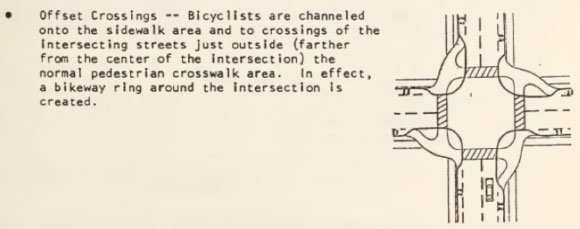
It seemed like the experts of the time were coalescing around an answer to one of the most important design challenges of bikeway planning: intersections. The 1976 FHWA report "Safety and Location Criteria for Bike Facilities," which created the basis for national bikeway design standards nationwide, mentions the offset intersection design as one of five intersection design treatments. The other four designs are all-too-familiar today: They simply remove all bicycle-specific features at the intersection -- forcing the rider to merge into the rightmost travel lane with motor vehicles and leaving the cyclist exposed until the bike lane begins again on the far side of the intersection. These designs are still considered standard today.
Unfortunately, the 1976 report’s discussion of the offset crossing design explains that the treatment was never studied and was excluded from consideration due to perceived deficiencies in the U.S. cycling public:
Prior to undertaking such studies, the offset crossing was dropped from consideration primarily due to the problems with bicyclist acceptance. Although this treatment has been successfully employ in Europe, it essentially involves treatment of bicyclists as pedestrians. All observational experience of U.S. cyclists would indicate certain rejection and disuse of such a facility by the vast majority. [Smith Jr., 1976]
It is clear that this highly influential document’s dismissal of the offset intersection design doomed any chance of installation at the time. But much like physically protected bikeways, this design has recently been rediscovered by cycling advocates and planners thanks to Nick Falbo's video about protected intersections. The idea (similar to the designs from over 40 years ago) was covered by dozens of news sources. The Streetsblog headline called it "The Next Breakthrough for American Bike Lanes."
Design consultants like Rock Miller have been carrying the torch of the design and sharing the idea with cities across the country for years -- but to no avail. Miller says that since Falbo’s video went viral, cities are receptive and excited to consider the design. Falbo himself suggested that the design was difficult to comprehend from the birds-eye view of the 1970s, and that it took the technology of 3D rendering to finally, easily explain the benefit of the design. “I had been pitching [the idea of a protected intersection] in various cities -- but struggled to get it accepted anywhere," he said. "Then, the design competition came up as an opportunity. The video was able to communicate it better than a memo -- people could see what it looked like passing through."
So, as advocates wait with excitement for Salt Lake City’s completion of its protected intersection, we should keep in mind that this is design has truly been a long time coming. While we can call the design innovative and groundbreaking, it’s important to realize that we are, simply, "re-cycling" the ideas of generations past, and it is the technology of today that has finally allowed this idea to come to fruition.
Marc Caswell is currently studying bicycle and pedestrian transportation at the Luskin School of Public Affairs at the University of California, Los Angeles. This article is a shortened version of his paper, “Re-Cycling Ideas: California’s Earliest Bikeway Planning Rediscovered 50 Years Later.”
